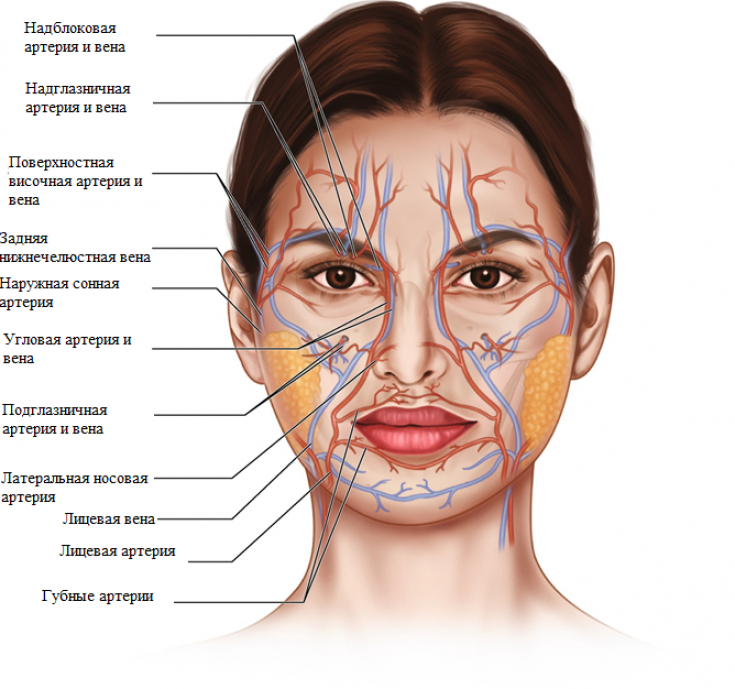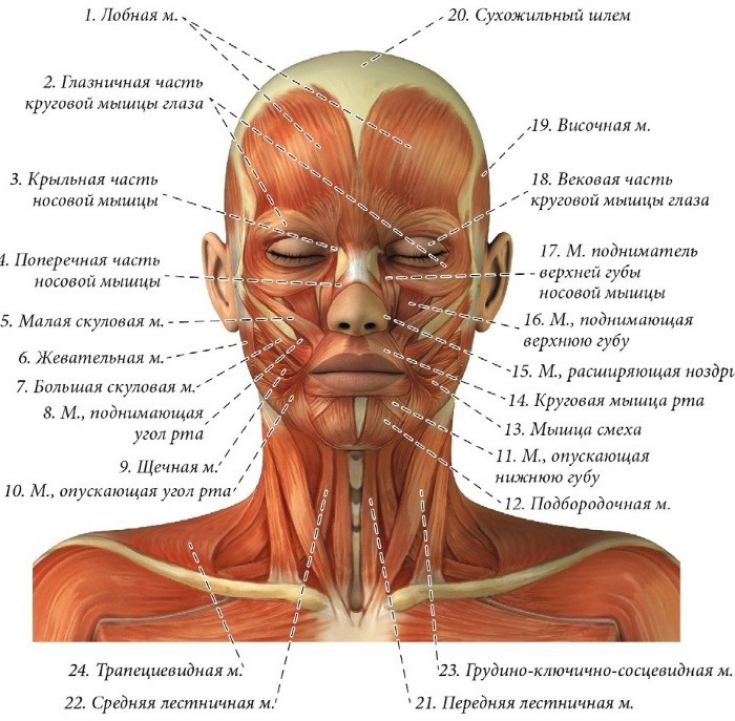Contour plastic surgery of the upper third of the face is associated with a number of risks – both controllable (eg, hemorrhage) and, in some cases, irreversible (blindness). Therefore, knowledge in the field of facial anatomy for cosmetologists performing correction with neuromodulators and dermal fillers tops the list of the most important conditions for the safety of injection procedures. In this article estet-portal.com Tracey Hotta talks about important aspects of the anatomy of the upper third of the face: the location and function of muscles, blood vessels and nerves in the forehead, between the eyebrows and temples.
- Anatomy of the forehead area: blood supply, frontalis muscle, innervation
- Anatomy of the glabellar area: glabellar complex, major arteries
- Anatomy of the temporal zone: temporalis muscle, vessels, fasciae
Anatomy of the forehead area: blood supply, frontalis muscle, innervation
Frontalis muscle (m. frontalis) – a large muscle that is located on the forehead and raises mainly the central part of the eyebrow.
The frontalis muscle originates at the hairline, from the cranial aponeurosis. The attachment point is located at the level of the eyebrows, where its fibers intertwine with muscle fibers:
- proud;
- eyebrow wrinkler,
- lowering an eyebrow;
- circular muscle of the eye.
Contractions of vertical muscle fibers m. frontalis over time leads to the appearance of horizontal wrinkles in the forehead area. At the temporal line, the frontalis muscle is partially located above the temporal.
Subscribe to our channel in Telegram!
Correction of the functional frontalis muscle can lead to "heaviness" of the or ptosis of the eyebrow. Relaxation of the frontalis muscle without its direct correction can be obtained by correcting the depressant action of the glabellar complex, the fibers of which are intertwined with m. frontalis.

Blood supply to the frontalis muscle is provided by:
- frontal branch of the superficial temporal artery (lateral);
- supratrochlear artery (medally);
- supraorbital artery (medially).
The superficial temporal artery emerges from the external carotid in the area of the mandible, ascends about 1 cm opposite the ear in the preauricular space, and crosses the zygomatic arch (anterior branch of the superficial temporal artery).
Because m. frontalis – the only levator muscle of the upper third of the face, it is important to evaluate its function before botulinum toxin injections.
frontal branch – the terminal branch of the superficial temporal artery, which anastomoses with the supraorbital arteries in the region of the frontalis muscle. The supratrochlear and supraorbital arteries emerge from the foramen located in the orbital ridge. The supratrochlear neurovascular bundle runs at a distance of approximately 1.7 cm from the midline of the forehead, and the supraorbital – 2.7 cm. These blood vessels exit through the muscles that lower the eyebrows and ascend to enter the frontalis muscle about 2 cm above the orbital ridge.
Read also: Forehead anatomy for injectionists: important nuances of the structure and correction of the zone
The temporal branch of the facial nerve is responsible for innervation of the frontalis muscle. The nerve emerges from under the parotid gland and passes upward through the zygomatic arch. It is located in loose connective tissue under the temporoparietal fascia. The nerve emerges from the deep plane into the superficial one as it crosses the lower surface of the frontalis muscle at the temporal line. The frontal cord of the superficial temporal artery passes above the nerve.
Anatomy of the glabellar area: main arteries, glabellar complex
The glabella complex of muscles in the area between the eyebrows consists of:
- muscles of the proud (procerus);
- eyebrow wrinkling muscle (corrugator supercilii);
- muscle that lowers the eyebrow (depressor supercilii).
The brow pucker originates at the medial brow ridge on the frontal bone and enters the skin of the medial brow. The supratrochlear neurovascular bundle exits through the corrugator supercilii and provides sensation and blood supply to the central part of the forehead. The puckering brow muscle compresses the medial part of the brow.
In 2012, Pessa and Rohrich found that fat compartments in the glabellar complex result in vertical lines (folds). The cosmetologist can use these folds as indicators of the position of the supratrochlear artery and nerve. When the brow complex is reduced, three folds appear:
- median;
- corrugatory;
- supraorbital.
There are fat compartments between them – medial and lateral. The location of the supratrochlear artery is indicated by the corrugator, and the supraorbital – supraorbital fold respectively.
Read also: Facial anatomy for injectors: how not to damage facial nerves when injecting dermal fillers
The supratrochlear artery runs under the brow-pucker muscle and the frontalis muscle, its superficial marker being the corrugator fold. As it travels upward through the frontalis muscle, the supratrochlear artery emerges to the surface and passes just under the skin. This creates a risk of damage to the central vessel of the forehead and impaired collateral circulation during the correction of the area between the eyebrows.

Because the supratrochlear and supraorbital arteries are branches of the ophthalmic branch of the internal carotid artery, it is important to be careful when augmenting the glabellar area with dermal fillers.
Injection of the filler into the supratrochlear artery can lead to occlusion of the central retinal artery and blindness.
Therefore, injections are recommended in the area between the eyebrows:
- superficial, directly under the dermis layer;
- low concentration hyaluronic acid;
- with low insertion force.
This will help reduce the risk of bleeding and vascular damage. Anatomy of the temporal zone: vessels, temporalis muscle, fasciae
Temporalis
(m. temportalis) has a fan-shaped shape and is located laterally in relation to the orbital ridge and above the zygomatic arch. M. temporalis intertwines with the masticatory muscle and participates in the chewing process.
Temporal fossa results from:
reabsorption of bone tissue;
- muscular atrophy;
- deflation of the fat package in the temporal zone. This results in drooping of the lateral brow and skeletalization of the face.
The temporal zone consists of
two fascial layers
: deep and superficial. The deep temporal fascia is separated from the superficial avascular plane by loose connective tissue. It attaches securely to the periosteum near the border of the temporalis muscle, but not to the zygomatic arch. The fascial layer closely adheres to the muscle and is not very pliable, especially in younger people. This factor must be taken into account when correction of the temporal zone with fillers. With age, the muscle under the temporal fascia atrophies, increasing the space for filler augmentation. In the area of the temporal cavity,
two techniques of gel injection can be used
:
Deep insertion into the periosteum with a needle;
- Introduction of cannulas into loose connective tissue between two layers of fascia. When working with the first technique, the location of the deep temporal arteries must be taken into account. Blood enters the temporal zone through two branches of the maxillary artery –
anterior and posterior deep temporal arteries
, as well as a branch of the external carotid artery – superficial temporal artery. In the temporal fossa, the posterior deep temporal artery and the deep temporal nerve enter the temporalis muscle. The artery supplies blood to the upper part of the temporal bone, the periosteum of the skull, and also to the temporalis muscle.

Marking for deep insertion of the filler into the temporal zone can be done in the superomedial part of the temporal cavity. This point is located at a distance of 1
.5 cm and 1 cm above the lateral part of the eyebrow
.
The temporal filler is injected into muscle
, not bone. The temporal muscle is closely connected with the periosteum. Since the deep temporal arteries run in the muscle, it is recommended to perform an aspiration test before injections. Temporal area augmentation may result in temporary visualization of vessels until the product is integrated into the tissue.
Second technique
is used for temporal cavity augmentation. The filler is injected with a needle or cannula into the loose connective tissue located between the two layers of the fascia. The frontal branch of the superficial temporal artery and vein, as well as the temporal branch of the facial nerve, are located in the superficial temporal fascia. When inserted correctly, movement of the needle or cannula under the vessels is observed. Knowledge of the anatomy of the upper third of the face – location of muscles, nerves and blood vessels of the frontal, brow and temporal zones – will help the beautician to carry out injection procedures as safely as possible and obtain the optimal correction result.
Adapted from Plastic Surgical Nursing.
More interesting videos on our
YouTube-channel!







Add a comment